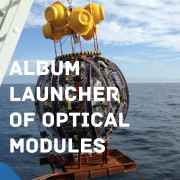Three more detection units for KM3NeT/ORCA
1 May 2023 – During a two days sea operation, 27-28 April 2023, three detection units were successfully connected to the ORCA detector of KM3NeT in a record time of just over 24 hours. In addition, an acoustic beacon was recovered for battery replacement. The total number of deployed ORCA units is now 18, as visible in the sonar scan above.








